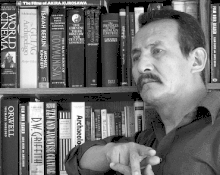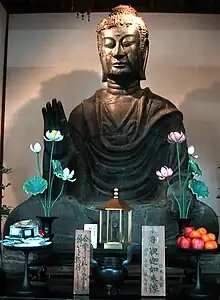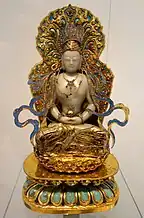| Part of a series on |
| Tibetan Buddhism |
|---|
 |
A Western tulku is a recognized reincarnation of a previous master, born in the West, commonly of non-Tibetan ethnic heritage, but also expatriate Tibetans born in the West or Westerners with heritage from the Tibetan cultural sphere (e.g. Mongolia).[1][2][3] The recognition of Westerners as tulku has occurred since the 1970s, following the spread of Tibetan Buddhism to modern Western countries such as the United States.
Western, especially non-Asian, tulku have prompted debate in Buddhist circles and the wider Tibetan communities, variously being interpreted as outgrowths of orientalism, or part of Tibetan Buddhism adapting to an global, transcultural political context.[4][5]
History and development
Background
In a strict sense, tulku is a Tibetan translation of the Sanskrit nirmāṇakāya, which refers to the "transformation" or "emanation body" of a Buddha. Tulku is therefore the physical "form in which a Buddha appears to ordinary beings."[7]
A related term in Tibetan is yangsi (literally "rebirth" or "re-becoming") which refers to an enlightened master who has returned to earthly existence for the sake of benefitting sentient beings. While the notion of a nirmāṇakāya is found throughout Mahayana Buddhism, and is integral to the doctrine of the trikaya or "Three Bodies", the concept of the yangsi is uniquely Tibetan. Tulku, as a title, refers to one who is recognized as the yangsi of a master.[8]
It arose in the context of a political vacuum spurred by the assassination of Ralpachen, which saw monastic centers develop political power in a "second spreading" of Buddhism in Tibet.[9] It had "purely politico-mercantile origins and functions" and later became a significant spiritual institution. However, some commentators argue that the political shift was "grafted onto the tradition of recognizing reincarnations, not the other way around."[10] Turrell V. Wylie wrote that the tulku system "developed in Tibetan Buddhism primarily for political reasons"[11] while Reginald Ray argued that such a view ignores "miss[es] what is perhaps its most distinctive feature" which is its "important ideological and religious dimensions", being "deeply rooted" in the bodhisattva concept:
Buddha Cākyamuni's [sic] role as the first and pre-eminent Bodhisattva is crucial for the Tulku tradition, because it means that every Tulku, in appearing on earth as a Bodhisattva, is following in the Buddha's footsteps [...] the very structure of a Tulku's life is patterened after the life of Cākyamuni.[11]
Tulku have been associated with ruling power since its origination, expressing indigenous Tibetan notions of kingship.[12] This system supplanted the earlier model of monastic governance, in which a celibate "religious head" acted as abbot, while his brother, a married "administrative head", continued the family line, with his eldest son becoming the next religious head, creating an uncle-nephew system of inheritance.[13] The first recognized tulku was perhaps Rangjung Dorje, 3rd Karmapa Lama.[14]
Foreign tulkus have been identified since at least the sixteenth century, when the grandson of the Mongol Altan Khan was recognized as the 4th Dalai Lama. The Mongol conversion to Buddhism served a political function and allowed Tibet to build a closer relationship with the Mongol Yuan Dynasty.[15] Traditionally, however, tulku were only recognized from Tibetan cultural areas, encompassing Tibet, Nepal, Mongolia, and Bhutan.[16]
Western interest and globalization
In the late 19th century, Laurence Waddell, an early Western explorer, dated the tulku system to a purely Tibetan innovation in the fifteenth century, although "purposefully obscured so as to give the appearance of antiquity", and distinguished it from the "orthodox Buddhist theory of rebirth as the result of karma."[17] Such opinions are typical of orientalist writers who are averse to perceived superstition, seen as an aberration on an originally rationalist tradition. Giuseppe Tucci traced the origin of tulku to Indian Vajrayana, particularly in a fragmentary biography of Maitripada he discovered in Nepal.[18]
The Chinese annexation of Tibet in 1959 created massive social upheaval. This intensified during the Cultural Revolution which brought irreparable damage to the institutions and traditions which constitute Tibetan Buddhism as one of the Four Olds. As a result, Tibetan Buddhism has flourished in areas of Tibetan culture not under Chinese rule, such as Nepal, Bhutan, and parts of North India. In India, the traditional monastic system is largely intact and the tulku system remains politically relevant.[19] Compounded with the inherent transnational character of proselytizing religions, Tibetan Buddhism is "pulled between the need to adapt itself and the need to preserve itself" in the face of Chinese occupation and Western fascination with Tibet (cf. Shangri-La).[20]
The mass exodus of Tibetans following the failed 1959 uprising led Tibetan refugees to search for reincarnate masters outside of Tibet.[21] The first Western tulku were expatriate Tibetans, Tibetans of mixed heritage, or members of related ethnic groups, such as Erdne Ombadykow (Kalmyk) or the sons of Chögyam Trungpa (Mongol-Tibetan and English-Tibetan).[22][23]
Native Westerners began converting to Tibetan Buddhism during the counterculture of the 1960s, and Tibetan Buddhism became popular among "elite" western Buddhists and they began to be recognized as incarnations of Buddhist masters around this time.[24][25] The first recognized white tulku was Dylan Henderson, an American boy identified as his father's teacher, or alternatively Ossian MacLise ( born in Kathmandu, Nepal.)[26][27] Initially, white Western tulkus were not recognized by the wider Tibetan diaspora.[28][22]
Notable Western tulku

Elijah Ary was the first Westerner to be recognized as a tulku in Gelug tradition.[29] Tenzin Ösel Hita was born to Spanish parents, both students at the Foundation for the Preservation of the Mahayana Tradition, in February 1985. He was confirmed as the reincarnate Thubten Yeshe, founder of the FPMT, by the Dalai Lama in 1986. Hita has been called a "transnational tulku".[30]
In 1988, Jetsunma Ahkon Lhamo (formerly Catharine Burroughs) was enthroned as a tulku at Kunzang Palyul Choling. This marked the first time a Western woman was recognized as a tulku.[31] Her late recognition and non-traditional lifestyle roused controversy.[32]
Steven Seagal was enthroned as tulku of Chungdrag Dorje, a 17th-century tertön or "treasure revealer", in February 1997. This prompted a debate as to whether traditional religious titles "have been put up for sale."[33] Penor Rinpoche, who has recognized several Western tulku including Ahkon Norbu Lhamo, defended his recognition of Seagal, arguing that it was not uncommon to recognize tulku late in life or for there to exist large gaps between incarnations of a tulku. He denied seeking monetary donations from Seagal.[34] Stephen Batchelor wrote that "my suspicion, and I must admit it's a cynical one, is that this is a political-financial move."[35] Seagal is involved in the international arms trade and the government of Russia,[36] which has prompted criticism of his title by English journalist Marina Hyde.[36]
Experiences of Western tulku
Western tulkus may struggle to gain acceptance among laypeople and even other monastics. Furthermore, a Western child identified as a tulku is compared to and made to identify with an adult of a completely different culture and historical setting.[37] The Tibetologist and tulku Elijah Ary noted that "the two terms are antithetical" for many Tibetans. Many Western tulku feel "their place still lies in the West."[38] Generally, they do not follow traditional Tibetan monastic life, and commonly leave their home monasteries for alternative careers, sometimes outside of chaplaincy or other spiritual roles, however this is a trend seen in Tibetan tulku as well.[39] In Western Buddhist communities, there is significantly more emphasis on laity, a greater participation of women, and a general orientation towards social justice than is seen in traditional Buddhist communities.[40] Ary suggests that the paths of Western tulku "lie outside of the monastery" and that through this they "[fulfil] part of [their] calling as Tulkus."[17]
Tulku Bino Naksang has described the phenomena of Western tulkus as a "failed experiment"[41] which did not account for the contradictions between traditional Tibetan culture and modern Western culture, maintaining that the tulku system is uniquely Tibetan. He has suggested that Westerners should develop their own forms of Buddhism rather than adapt to the Tibetan system.[42] The current Dalai Lama is uncertain whether the recognition of Western tulku is beneficial.[43]
Analysis and academic responses

Elijah Ary has argued that the recognition of Western tulku is evidence that the wider tulku system is not entirely sociopolitical.[44] The identification of non-Tibetan tulku has been called a manifestation of "the creative potential of Tibetan people [...] to adjust and survive in a changing world" and seen as an indications that Tibetan Buddhism is acquiring a more "globalized" character, as the tulku system is important to the maintenance and transmission of Tibetan Buddhism.[45] Raymond Lee and Susan Ackerman argue that the recognition of Western tulkus "enhances the image of the Tibetan hierocracy as being open to change", occurring in a critical moment and "market-like situation that thrives on syncretic ideas and practices."[46] Donald Lopez suggests that the recognition of Western tulkus is "a form of spiritual adaptation that Tibetans use to gain allegiance from Western countries in order to strengthen their protest against China's occuptation."[47]
The academic Abraham Zablocki uses the term "tulku envy" to describe a Western desire to "be[come] Tibetan" or inhabit a Tibetan body through the tulku system, where the prospective of a unique, subjectively exotic identity can be ego-aggrandizing, holding that the desire to trade one's Western-ness for an idealized image of Tibetan-ness is essentially cultural-appropriative:[48]
The longing for a Tibetan body, or more precisely, the longing to discover that one's Western body is actually a vessel holding a Tibetan identity, reveals something of the symbolic potency that Tibetan-ness continues to hold for so many in the West.[49]
Zablocki analyzes The Mandala of Sherlock Holmes, by the Tibetan activist and writer Jamyang Norbu, as a satire of this tulku envy, in an act of "counter-appropriation" in which a Western culture heroes becomes a Tibetan rather than vice-versa.[50] Norbu himself is critical of the place of Buddhism in the Tibetan exile community, as well as the "whimsies of western dharma-types, enamoured with everything 'traditional' or 'mystical' in Tibet."[51]
See also
References
- ↑ "The Enthronement of Aka Nyima (Tulku Wyatt) | Windhorse Archives | Chagdud Gonpa Foundation". chagdudgonpa.org. Retrieved 31 October 2023.
- ↑ Mackenzie 1996.
- ↑ Moran 2004.
- ↑ Ary 2012, pp. 398–427.
- ↑ Usarski 2005, p. 347.
- ↑ Wayman, Alex; Tajima, Ryujun (1992). The Enlightenment of Vairocana: Study of the Mahāvairocana-Sūtra. Motilal Banarsidass Publishers. ISBN 1-884997-86-4.
- ↑ Ary 2012, pp. 399–400.
- ↑ Ary 2012, pp. 400–401.
- ↑ Ray 1986, p. 44.
- ↑ Ary 2012, p. 409.
- 1 2 Ray 1986, p. 37.
- ↑ Ray 1986, p. 43.
- ↑ Ray 1986, p. 45.
- ↑ Oldmeadow 2001, p. 269.
- ↑ Bhushan, Garfield & Zablocki 2009, p. 45.
- ↑ Ary 2012, p. 398.
- 1 2 Ary 2012, p. 404.
- ↑ Ray 1986, p. 42.
- ↑ Oldmeadow 2001, p. 266-267.
- ↑ Bhushan, Garfield & Zablocki 2009, p. 44.
- ↑ Ary 2012, p. 398-399.
- 1 2 Ary 2012, pp. 410.
- ↑ John-Paul Flintoff (13 April 2012). "Did I know you in a past life?". The Guardian. Retrieved 30 October 2023.
- ↑ Jan Nattier, 'Visible and Invisible: The Politics of Representation in Buddhist America', Tricycle, Vol. 5, No. 1, 1995, pp. 42–9.
- ↑ Oldmeadow 2001, p. 267.
- ↑ Juhasz & Lebow 2015, p. 351.
- ↑ Liechty 2017, pp. 364.
- ↑ deJong 1974, pp. 55–106.
- ↑ Ken Gewertz (21 February 2002). "Old soul - Ary sees himself as a bridge between East and West". Harvard Gazette. Retrieved 4 November 2023.
- ↑ Falcone, Jessica Marie. "A Transnational Tulku: The Multiple Lives of FPMT's Spanish-Born Lama Ösel." Revue d’Etudes Tibétaines 38 (2017): 220–240.
- ↑ "The Unexpected Incarnation". Washington Post. Retrieved 31 October 2023.
- ↑ Swanepoel, Elizabeth (July 2015). "How Western Nuns and Buddhologists are Transforming Tibetan Buddhism's Male Face". Journal of Gender and Religion in Africa. 12 (1): 101–119.
- ↑ Lattin, Don; Writer, Chronicle Religion (20 June 1997). "Movie Star Declared a Lama / Seagal elevated to sacred status..." SFGATE. Retrieved 31 October 2023.
His spiritual elevation to 'tulku' has raised eyebrows in American Buddhist circles and has provoked a heated debate on the Internet over whether Tibetan titles have been put up for sale.
- ↑ "Advice Regarding Recognition of Tulkus (Steven Seagal) | Palyul.org". palyul.org. Retrieved 31 October 2023.
- ↑ Nancy Griffin, "The Buddha From Another Planet." Esquire, October 1997.
- 1 2 Hyde, Marina (24 September 2015). "Has Steven Seagal proved you can be a Buddhist and a mascot for the arms trade?". the Guardian. Retrieved 31 October 2023.
- ↑ Ary 2012, pp. 422.
- ↑ Ary 2012, pp. 425.
- ↑ Ary 2012, pp. 426–427.
- ↑ Oldmeadow 2001, p. 270.
- ↑ Miller, Andrea (12 March 2021). "Magical Emanations: The Unexpected Lives of Western Tulkus". Lion's Roar. Retrieved 30 October 2023.
Tulku Bino Naksang, who is of Tibetan heritage, comments on Tibetan Buddhist teachers recognizing Westerners as tulkus. 'It was a failed experiment,' he says bluntly.
- ↑ Miller, Andrea (12 March 2021). "Magical Emanations: The Unexpected Lives of Western Tulkus". Lion's Roar. Retrieved 30 October 2023.
- ↑ Ary 2012, p. 427.
- ↑ Ary 2012.
- ↑ Usarski 2005, p. 347-355.
- ↑ Lee & Ackerman 2018, pp. 30–31.
- ↑ Bramadat & Seljak 2009, p. 84.
- ↑ Atay & D'Silva 2019, p. 222.
- ↑ Bhushan, Garfield & Zablocki 2009, p. 43-53.
- ↑ Bhushan, Garfield & Zablocki 2009, pp. 51–52.
- ↑ Jamyan Norbu (31 May 2007). "Trapped by Buddha". New Humanist. Retrieved 1 November 2023.
Works cited
- Ary, Elijah (2012-11-19). "The Westernization of Tulkus". Little Buddhas. Oxford University Press New York. pp. 398–427. doi:10.1093/acprof:oso/9780199860265.003.0017. ISBN 978-0-19-994561-0.
- Atay, A.; D'Silva, M.U. (2019). Mediated Intercultural Communication in a Digital Age. Routledge Research in Communication Studies. Taylor & Francis. ISBN 978-1-351-39989-0. Retrieved 2023-10-31.
- Bhushan, Nalini; Garfield, Jay L.; Zablocki, Abraham, eds. (2009). TransBuddhism: Transmission, Translation, Transformation. Amherst: University of Massachusetts Press. ISBN 978-1-55849-708-5.
- Bramadat, Paul; Seljak, David (2009-01-01). Religion and Ethnicity in Canada. University of Toronto Press. ISBN 978-1-4426-1018-7.
- deJong, J. W. (1974). "A Brief History of Buddhist Studies in Europe and America". The Eastern Buddhist. Eastern Buddhist Society. 7 (1): 55–106. ISSN 0012-8708. JSTOR 44361384. Retrieved 2023-10-31.
- Juhasz, Alexandra; Lebow, Alisa (2015-03-16). A Companion to Contemporary Documentary Film. Malden, Mass: John Wiley & Sons. ISBN 978-0-470-67164-1.
- Lee, Raymond L. M.; Ackerman, Susan E. (2018-05-08). The Challenge of Religion after Modernity. Routledge. ISBN 978-1-351-73484-4.
- Liechty, Mark (2017). "12. Imbibing Eastern Wisdom: Nepal as Dharma Destination". Far Out. University of Chicago Press. pp. 323–366. doi:10.7208/chicago/9780226429137.003.0012. ISBN 978-0-226-42894-9.
- Mackenzie, Vicki (1996-04-02). Reborn in the West. Da Capo Press. ISBN 978-1-56924-804-1.
- Moran, Peter Kevin (2004). Buddhism Observed. London: Routledge. ISBN 978-0-415-32596-7.
- Oldmeadow, Peter (2001). "Tibetan Buddhism and Globalisation". Sydney Studies in Religion. ISSN 1444-5158. Retrieved 2023-11-01.
- Ray, Reginald (1986). "Some Aspects of the Tulku Tradition in Tibet". The Tibet Journal. 11 (4): 35–69.
- Sherrill, Martha (2000). The Buddha from Brooklyn. Random House Digital, Inc. ISBN 978-0-679-45275-1.
- Trzebuniak, Jacek (2014). "Analysis of Development of the Tibetan Tulku System in Western Culture". Polish Journal of the Arts and Culture. 2 (10): 115–130.
- Usarski, Frank (2005-12-31). "(Re)Making Tradition in an International Tibetan Buddhist Movement: A Lesson from Lama Gangchen and Lama Michel". Historicizing "Tradition" in the Study of Religion. DE GRUYTER. pp. 345–356. doi:10.1515/9783110901405.345. ISBN 978-3-11-018875-2.
Further reading
- Coleman, James William. The New Buddhism: The Western Transformation of an Ancient Tradition, Oxford University Press, 2002.
- McLeod, Ken (September 15, 2016). "Reflections on Dzongsar Khyentse's 'How We Raise Tulkus'". Tricycle: The Buddhist Review. Retrieved 2023-11-05.

